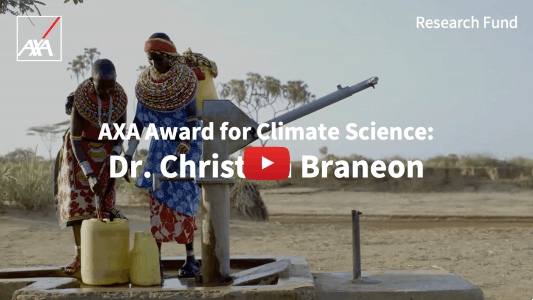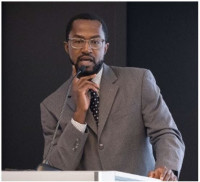Climate Change
City Resilience
AXA Awards
United States
Centering Equity and Environmental Justice in the Context of Climate Adaptation
Watch the video and read his interview below:

Tell us about yourself and the genesis of your interest in climate change and environmental justice.
My love affair with hydrology and civil engineering started when I was a senior in high school and crystallized after encountering Tropical Storm Alison firsthand while interning as a college student at Johnson Space Center in 2001. After studying abroad in Nagoya and Tokyo in the early 2000s, I began following the Kyoto Protocol and my interest in environmental and climate policy began to grow from there. Anthropogenic climate change has always been a fascinating phenomena to me because wealthier countries are largely responsible for the current high levels of greenhouse gas (GHG) emissions in the atmosphere. Furthermore, vulnerable and marginalized people are often disproportionately affected by climate change at the regional scale and urban scale.
Environmental justice is a principle affirming that no community should bear an unfair share of the environmental burden, and that environmental benefits should be shared in an equitable way regardless of race, class, gender or other axes of exclusion. I have spent my career helping stakeholders understand the projected distribution of climate change impacts at global as well as local levels in order to develop equitable adaptation strategies that are both scalable and sustainable.
My research and professional practice focus on climate variability, climate adaptation and their intersection with environmental justice. I use systems approaches to assess climate change impacts on urban, agricultural, and natural environments. I chose this field of research because climate change is likely to exacerbate existing inequality.
How does your work impact the world we live in?
My agricultural research focuses on using (a) measured agricultural water use along with (b) geostatistical techniques, (c) crop models, and (d) general circulation models (GCMS) to assess irrigation demand and the uncertainty associated with demand projections at spatial scales relevant to water resources management. This research has informed the regional water planning in the Apalachicola-Chattahoochee-Flint River Basin shared by Georgia, Florida, and Alabama.
One of my goals is to transform the civil engineering industry by bridging the gap between climate science and engineering practice. In 2013, I developed an approach for integrating climate change projections into the City of Dallas’s Long Range Water Supply Plan. The fact that Dallas became the first large city in Texas to integrate climate projections into its water supply planning efforts is a source of professional satisfaction for me.
I served as Co-Director of the US Environmental Protection Agency’s (USEPA) inaugural (2015-2016) Environmental Justice Academy (EJA) for community leaders. The EJ Academy teaches participants a basic understanding of environmental justice and environmental regulations, providing tools for leveraging resources to ensure successful collaboration and negotiations in their local communities on issues related to the environment and public health.
Developing a more robust understanding of green roof and park performance is critical for local policymakers and urban planners as they implement heat management strategies under a changing climate. My research team at the GISS Climate Change Research Initiative (CCRI) currently uses publicly available archives of satellite imagery and open-source software to evaluate the cooling effects of green infrastructure. I use “co-production” as a tool for integrating satellite data and climate science into urban planning and civil engineering practice.
What are your most recent projects and what are you currently working on?
My research team is preparing for workshops on urban heat island mapping that are part of the Urban Climate Change Research Network’s (UCCRN) Urban Design Climate Workshop series.
Recently, I advised the New York City Council’s Data Operations Unit on their data science strategy as they integrated Landsat 8 imagery into their temperature mapping initiatives. I am also advising the City of Chicago Department of Public Health as it integrates MODIS satellite data into an air quality focused dashboard that is currently in development.
I serve as co-investigator on a research project that will produce new data products, providing new information and insights on the role of coastal marshes in the global carbon and nutrient cycles. Coastal marshes are highly valued for the ecosystem services they provide, yet they are disappearing at an alarming rate worldwide due to seawater intrusions. The submergence of coastal marshes transforms them from sinks to sources of greenhouse gases, further accelerating climate change and rates of sea-level rise.
Do you have any advice for scientists who want to pursue a career in your field?
Remember that cultural humility and leadership skills will set you apart from your peers in climate science. I am fortunate that I was able to take professional communication courses and study abroad while I was an undergraduate student at Morehouse College. In addition, my experiences serving as a teaching assistant for leadership courses in the School of Public Policy at the Georgia Institute of Technology (Georgia Tech) made my graduate school experience more well-rounded and fulfilling.
Selected Publications and Datasets by Dr. Christian Braneon
Kruczkiewicz, A., J. Klopp, J. Fisher, S. Mason, S. McClain, N.M. Sheekh, R. Moss, R.M. Parks, and C. Braneon, 2021: Opinion: Compound risks and complex emergencies require new approaches to preparedness. Proc. Natl. Acad. Sci., 118, no. 19, e2106795118, doi:10.1073/pnas.2106795118.
Naimark, J.G., A.M. Fiore, X. Jin, Y. Wang, E. Klovenski, and C. Braneon, 2021: Evaluating drought responses of surface ozone precursor proxies: Variations with land cover type, precipitation, and temperature. Geophys. Res. Lett., 48, no. 7, e2020GL091520, doi:10.1029/2020GL091520.
Braneon, C., C. Rosenzweig and D. Bader. 2021. Global 0.25-Degree Grids of Extreme Heat Projection (RCP8.5 2050s) and Baseline Conditions (1980-2005), v1 (Preliminary Release). Palisades, NY: NASA Socioeconomic Data and Applications Center (SEDAC). http://www.ciesin.columbia.edu/data/global-grid-extreme-heat-projection-2050-baseline-1980-2005-v1/.
Braneon, C. and C. Rosenzweig. 2021. Global 0.5-Degree Grids of Streamflow Decline Projection (RCP8.5 2050s), v1 (Preliminary Release). Palisades, NY: NASA Socioeconomic Data and Applications Center (SEDAC). http://www.ciesin.columbia.edu/data/global-grid-sf-decline-projection-2050-v1/.
Braneon, C., C. Rosenzweig, A. Ruane, and M. Phillips. 2021. Global 0.5-Degree Grids of Yield Decline Projection (RCP8.5 2050s) for Rainfed Crops, v1 (Preliminary Release). Palisades, NY: NASA Socioeconomic Data and Applications Center (SEDAC). http://www.ciesin.columbia.edu/data/global-grid-yield-decline-2050-v1/.
July 21, 2021

Christian
BRANEON
Institution
Barnard College- Columbia University
Country
United States
Nationality
American
Related articles
Climate Change
Food & Nutrition
AXA Chair
Argentina
Harnessing the Potential of RNA: Pioneering a Sustainable Path to Climate-Resilient Crops
Federico Ariel's research project addresses this critical threat to global agricultural productivity and offers a potential solution. His focus on... Read more

Federico
ARIEL
National University of the Litoral (UNL)
Climate Change
Post-Doctoral Fellowship
Hungary
How Will Climate Change Affect Bird-Spread Diseases
Expected start date:Aug-2023 Human, animal, and environmental health are interconnected. Climate change may alter the transmissions of diseases that can... Read more

Tamara
SZENTIVANYI
.thumbnail.jpg)